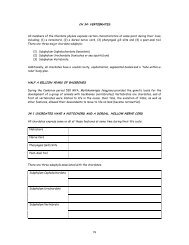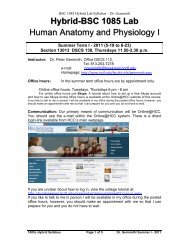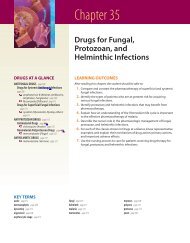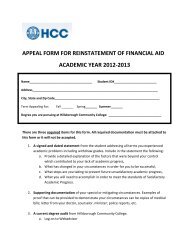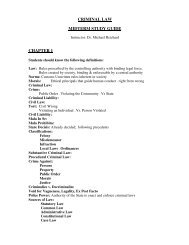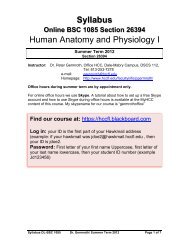Antimicrobial Drugs
Antimicrobial Drugs
Antimicrobial Drugs
You also want an ePaper? Increase the reach of your titles
YUMPU automatically turns print PDFs into web optimized ePapers that Google loves.
M34_ADAM9811_03_SE_CH34.QXD 12/30/09 1:16 PM Page 498<br />
498 Unit 5 The Immune System<br />
NURSING PROCESS FOCUS<br />
Interventions and (Rationales)<br />
■<br />
■<br />
■<br />
■<br />
■<br />
Monitor for development of red-man syndrome in patients receiving<br />
vancomycin. Report any significantly large area of reddening such as trunk, head<br />
or neck, limbs, or gluteal area especially if associated with decreased blood<br />
pressure or tachycardia. (Vancomycin hypersensitivity may cause the release of<br />
large amounts of histamine. If a significant area is involved, vasodilation from<br />
histamine may cause hypotension and reflex tachycardia. Giving IV drip more<br />
slowly may prevent or decrease the effects of the syndrome.)<br />
Monitor electrolytes, pulse, and ECG if indicated in patients on penicillins. (Some<br />
preparations of penicillin may be based in sodium or potassium salts and may<br />
cause hypernatremia and hyperkalemia.)<br />
Monitor patients on fluoroquinolones for leg or heel pain, or difficulty walking.<br />
(Fluoroquinolones have been associated with tendinitis and tendon rupture,<br />
especially of the Achilles tendon.)<br />
Assess for the possibility of pregnancy or breast-feeding in patients prescribed<br />
tetracycline antibiotics. (Tetracyclines affect fetal bone growth and teeth<br />
development, causing permanent yellowish-brown staining of teeth.)<br />
Women of child-bearing age taking penicillin antibiotics should use an<br />
alternative form of birth control to prevent pregnancy. (Penicillins may reduce<br />
the effectiveness of oral contraceptives.)<br />
Patient understanding of drug therapy:<br />
■ Use opportunities during administration of medications and during assessments<br />
to discuss the rationale for drug therapy, desired therapeutic outcomes, most<br />
common adverse effects, parameters for when to call the health care provider,<br />
and any necessary monitoring or precautions. (Using time during nursing care<br />
helps to optimize and reinforce key teaching areas.)<br />
Patient self-administration of drug therapy:<br />
■ When administering medications, instruct the patient and/or family/caregiver in<br />
proper self-administration techniques followed by return demonstration. (Proper<br />
administration increases the effectiveness of the drug.)<br />
PATIENTS RECEIVING ANTIBACTERIAL THERAPY (Continued)<br />
Implementation<br />
Evaluation of Outcome Criteria<br />
Patient and Family Education<br />
■<br />
■<br />
■<br />
■<br />
■<br />
■<br />
■<br />
Instruct the patient to immediately report unusual flushing,<br />
especially involving a large body area; dizziness; dyspnea; or<br />
palpitations.<br />
Teach the patient to promptly report any palpitations or dizziness.<br />
Instruct the patient to immediately report any significant or<br />
increasing heel, lower leg or calf pain, or difficulty walking to the<br />
provider.<br />
Advise women who are pregnant, breast-feeding, or attempting to<br />
become pregnant to advise their health care provider before<br />
receiving any tetracycline antibiotic.<br />
Teach women of child-bearing age on oral contraceptives to consult<br />
their health care provider about birth control alternatives if penicillin<br />
antibiotics are used.<br />
The patient and/or family/caregiver should be able to state the<br />
reason for the drug; appropriate dose and scheduling; what adverse<br />
effects to observe for and when to report; and the anticipated length<br />
of medication therapy.<br />
Teach the patient to take the medication as follows:<br />
■ Complete the entire course of therapy unless otherwise instructed.<br />
■ Avoid or eliminate alcohol. Some antibiotics (e.g., cephalosporins)<br />
cause significant reactions when taken with alcohol and alcohol<br />
increases adverse GI effects of the antibacterial.<br />
■ Take the drug with food or milk but avoid acidic beverages. If<br />
instructed to take the drug on an empty stomach, take with a full<br />
glass of water.<br />
■ Take the medication as evenly spaced throughout each day as<br />
feasible.<br />
■ Do not take tetracycline with milk products, iron-containing<br />
preparations such as multivitamins, or with antacids.<br />
■ Increase overall fluid intake while taking the antibacterial drug.<br />
■ Discard outdated medications or those no longer in use. Review<br />
medicine cabinet twice a year for old medications.<br />
Evaluate the effectiveness of drug therapy by confirming that patient goals and expected outcomes have been met (see “Planning”).<br />
See Tables 34.2 through 34.9 for lists of drugs to which these nursing actions apply.<br />
# 102887 Cust: PE/NJ/CHET Au: ADAMS Pg. No. 498<br />
Title: Pharmacology for Nurses Server: Jobs2<br />
C/M/Y/K<br />
Short / Normal<br />
DESIGN SERVICES OF<br />
S4CARLISLE<br />
Publishing Services



